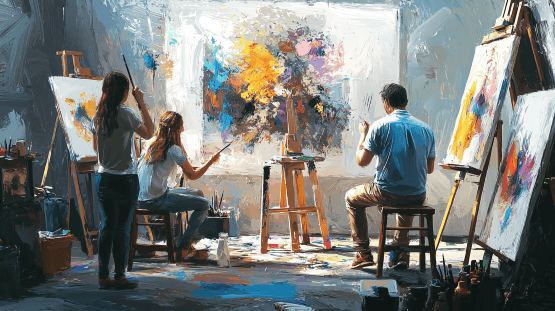Creating art is a skill, but describing it? That’s an art in itself.
Whether you’re an artist, gallery owner, or social media curator, a great artwork description can make all the difference. It’s not just about providing facts—it’s about sparking curiosity, evoking emotion, and drawing people into your work.
Let’s dive into how to craft descriptions that captivate your audience and showcase your art at its best.
Why Do Artwork Descriptions Matter?
Before we get into the “how,” let’s talk about the “why.”
A strong description can:
- Provide Context: Share the title, medium, size, and when you created it—details that ground the viewer in your piece.
- Enhance Understanding: Explain your inspiration or the story behind the work to deepen the connection.
- Evoke Emotion: Use words that make people feel something.
- Drive Engagement: Keep people looking at your work longer, sparking conversations and shares.
- Boost Sales: For collectors, a meaningful description can be the push they need to make a purchase.
- Improve Online Visibility: Descriptions packed with relevant keywords help search engines find your art.
What Makes a Great Artwork Description?
Think of your description as a mini-story about your piece. A strong one has these key elements:
1. Title
- Keep it short but meaningful.
- Choose something that reflects the mood or theme of the work.
2. Medium
- Clearly state the materials: oil on canvas, acrylic on wood, mixed media, etc.
3. Dimensions
- Include the size (height x width x depth) so viewers can visualize the piece.
4. Year of Creation
- Share when the piece was made it gives context and relevance.
5. Artist Statement (Brief)
- Include a sentence or two about your inspiration or intention behind the piece.
6. Descriptive Narrative
- This is the heart of your description. Paint a vivid picture with words to bring your artwork to life.

How to Write a Captivating Narrative
Your narrative is what makes people feel something about your art. Here’s how to nail it:
1. Show, Don’t Just Tell
Instead of saying, “This is a vibrant sunset,” describe it like this:
“Emerald green hills rise gently toward a sky painted with fiery oranges and soft pinks as the sun dips below the horizon.”
2. Focus on Emotion
Think about what you want the viewer to feel peace, excitement, mystery. Use words that match those vibes.
3. Tell a Story
Every artwork has a backstory. Whether it’s the inspiration behind it or what you felt while creating it, share the tale.
4. Use Vivid, Sensory Language
Make the viewer see, hear, and feel the scene. Describe textures, light, colors, and even movement.
5. Keep it Clear
Avoid jargon or overly technical terms unless your audience is highly specialized. Make it accessible to everyone.
6. Match the Tone
Your tone should reflect the piece. A playful abstract work calls for a different tone than a somber portrait.
How to Optimize Artwork Descriptions Online
If your art is on a website or online portfolio, SEO (search engine optimization) can help more people find it.
1. Use Keywords
Think about what collectors or fans might search for. Examples: “abstract bronze sculpture” or “Tuscan landscape painting.”
2. Add Image Alt Text
Describe your artwork in the image metadata. Search engines will thank you.
3. Write Enticing Meta Descriptions
Include a short, keyword-rich description that shows up in search results.
Tailor Your Descriptions to Different Platforms
Every platform has its own vibe, so adjust accordingly:
- Online Galleries: Go into detail and include keywords for better SEO.
- Social Media: Short and snappy. Use hashtags to expand your reach.
- Physical Galleries: Focus on emotion and keep it concise for labels or brochures.
- Your Portfolio: Balance narrative flair with clear details.
Examples of Effective Descriptions
Example 1: Landscape Painting
Title: Golden Hour Serenity
Medium: Oil on canvas
Dimensions: 24″ x 36″
Year: 2024
“Golden Hour Serenity” captures the peaceful beauty of the Tuscan countryside at sunset. Rolling hills, lush with vineyards, stretch to the horizon, bathed in golden light. Cypress trees silhouetted against a sapphire sky, while delicate brushstrokes evoke a sense of timeless stillness. This piece invites viewers to pause, reflect, and escape into nature’s embrace.
Example 2: Abstract Sculpture
Title: Convergence
Medium: Bronze
Dimensions: 12″ x 18″ x 8″
Year: 2023
“Convergence” explores the tension between movement and stillness. Swirling bronze shapes seem to freeze mid-motion, creating dynamic energy. Shadows play across the textured surface, drawing attention to intricate details. This sculpture encourages interpretation, sparking personal connections and endless dialogue.
Tips for Refining Your Approach
- Test different styles of descriptions and see what resonates most with your audience.
- Track how long people engage with your artwork online—longer times mean better descriptions.
- Ask for feedback from peers or viewers to fine-tune your writing.
Final Thoughts
Mastering artwork descriptions is more than a marketing skill—it’s a way to deepen your connection with viewers.
By combining vivid language, emotional resonance, and practical details, you can elevate your work and leave a lasting impression.
Start crafting descriptions that make your art sing—and watch your audience grow.
Your art deserves to be seen and understood. Ready to start? Pick a piece, write its story, and share it with the world. You can use our Free Toold to help you craft a great artwork description.